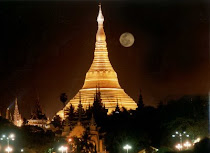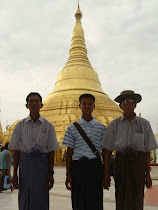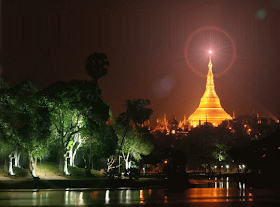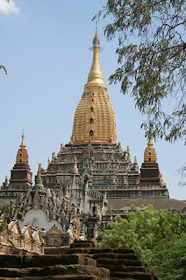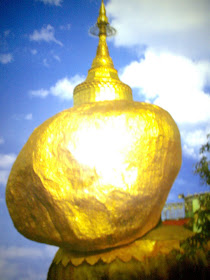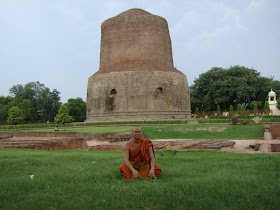ဓမၼစၾကာအခါေတာ္ေန႔ (၀ါဆုိလျပည့္)
0 comments Wednesday, July 28, 2010၁၃၇၂-ခု၊ ဒုတိယ ၀ါဆုိလျပည့္ေန႔သည္ ဓမၼစၾကာအခါေတာ္ေန႔ ျဖစ္ပါသည္။ ထုိ႔ေန႔၌ လြန္ခဲ့ေသာ (၁၀)ႏွစ္ခန္႔က ဘ၀နတ္ေက်ာင္း ေျပာင္းေရြ႕သြားေသာ မယ္ေတာ္ႀကီး ေဒၚက်င္သိန္း၊ လြန္ခဲ့ေသာ(၁)ႏွစ္ခန္႔က ဘ၀နတ္ေက်ာင္း ေျပာင္းေရြ႕သြားေသာ ရဟန္းမယ္ေတာ္ႀကီး ၾကီးေတာ္ ေဒၚက်င္ျမ၊ လြန္ခဲ့ေသာ(၇)ႏွစ္ခန္႔က ဘ၀နတ္ေက်ာင္း ေျပာင္းေရြ႕သြားေသာ အမႀကီး ေဒၚအုန္းျမင့္ႏွင့္၊ လြန္ခဲ့ေသာ(၁)ႏွစ္ခန္႔က ဘ၀နတ္ေက်ာင္း ေျပာင္းေရြ႕သြားေသာ အစ္ကိုႀကီး ကုိ၀င္းစိန္တုိ႔အား ေကာင္းမႈကုသုိလ္ျဖစ္ပါေစျခင္းအလို႔ငွါ စာေရးသူႏွင့္အတူေန စာသင္သား သံဃာေတာ္ အပါး(၂၀)ပါးတုိ႔ကုိ ဆြမ္းကပ္ၿပီး မိမိျပဳသမွ် ကုသလကုိ မယ္ေတာ္ႀကီးႏွင့္တကြ ဘုံသုံးဆယ့္တစ္ ေ၀ေနယ်သတၱ၀ါတုိ႔အား အမွ်ကုသုိလ္ ေပးေ၀ငွပါသည္ ေကာင္းေထြသာဓု ေခၚဆုိႏုိင္ၾကပါေစကုန္သတည္း။ သာဓုေခၚဆုိႏုိင္ၾကကုန္သည္ျဖစ္၍ ကုိယ္္စိတ္ႏွစ္ျဖာ က်န္းက်န္းမာမာ ခ်မ္းခ်မ္းသာသာ ရွိၾကပါေစကုန္သတည္း။
သဓု၊ သာဓု၊ သာဓု။
ရွင္သုခ(မင္းလွ)
read more “ဓမၼစၾကာအခါေတာ္ေန႔ (၀ါဆုိလျပည့္)”
သဓု၊ သာဓု၊ သာဓု။
ရွင္သုခ(မင္းလွ)
A Summary of what I have done
0 comments Sunday, July 25, 2010The title of my Thesis is "A Study of Buddhism in Burma (3rd Century BC to 13th century A.D) and it is divided into seven chapters: ( I ) Introduction, ( II ) Spread of Buddhism in Burma, ( III ) Buddhist Literature in Burma ( IV ) Buddhist Monuments in Burma, ( V ) Buddhist Sculptural remains in Burma, ( VI ) Various Buddhist Schools in Burma, ( VII ) Conclusion. Out of seven Chapters, the first chapter is "Introduction" and it is subdivided into five titles.
In the first title, briefly I mention the Geography of Burma with brief presentation of climate of Burma and then the second title is arranged in the subject of the History of Burma.
In this regard, I present the situations of historical succession, from by the mid- 900s BC to 1989 AD, as to how, early migration of three tribes (the tribe of Mon, Tibeto-Burma speaking Pyu, and Tibeto-Burman speaking Burmans or the Bamar) to Ayeyarwady Valley, warfare among tribes regarding invading to the land, introducing of Buddhism to Myanmar, etc.
The third title is "What Buddhism is". In this title, I emphasize on the Four Noble Truth and the Noble Eightfold Path not only because these two teachings are vital essences of Buddhism and but also because these enable to point out the path or way the final liberation or happiness for those who want to come to the end of suffering.
The fourth one is A summary of what I have done (i.e., this title),
And the title of Research Methodology and Sources comes into the final arrangement of the chapter (I). In that case, I present completely how and why I attempt my research work.
Shin Sukha(Min Hla)
ွ
ွွ
read more “A Summary of what I have done”
In the first title, briefly I mention the Geography of Burma with brief presentation of climate of Burma and then the second title is arranged in the subject of the History of Burma.
In this regard, I present the situations of historical succession, from by the mid- 900s BC to 1989 AD, as to how, early migration of three tribes (the tribe of Mon, Tibeto-Burma speaking Pyu, and Tibeto-Burman speaking Burmans or the Bamar) to Ayeyarwady Valley, warfare among tribes regarding invading to the land, introducing of Buddhism to Myanmar, etc.
The third title is "What Buddhism is". In this title, I emphasize on the Four Noble Truth and the Noble Eightfold Path not only because these two teachings are vital essences of Buddhism and but also because these enable to point out the path or way the final liberation or happiness for those who want to come to the end of suffering.
The fourth one is A summary of what I have done (i.e., this title),
And the title of Research Methodology and Sources comes into the final arrangement of the chapter (I). In that case, I present completely how and why I attempt my research work.
Shin Sukha(Min Hla)
ွ
ွွ
ေရႊဟသၤာဆရာေတာ္
0 comments Tuesday, July 6, 2010ေရႊဟသၤာဆရာေတာ္ႀကီးသည္ သီတဂူၾသ၀ါဒါစရိယဆရာေတာ္ႀကီးတစ္ပါးျဖစ္ပါသည္။ ဆရာေတာ္ႀကီးသည္ သီတဂူၾသ၀ါဒခံယူပြဲ၌ ေအာက္ပါ လကၤာေလးျဖင့္ ဆုံးမၾသ၀ါဒေပးခဲ့ပါသည္။ ရဟန္း၊ ရွင္၊ လူ၊ သူေတာ္၊ သီလရွင္အေပါင္း က်င့္ႀကံသြားလာ ေနထုိင္က်င့္သုံးရမည့္ ေဆာင္ပုဒ္ကေလးျဖစ္ပါသည္။
သူအမ်ားအက်ဳိး၊ ရြက္သည္ပုိးက။
ခႏုိးခနဲ႔၊ ဆုိကဲ့ရဲ႕လည္း၊
မဖဲ့အေစာင္း၊ ကုိယ့္လမ္းေၾကာင္းကုိ၊
စိတ္ေကာင္းႏွင့္ယွဥ္၊ ေရွ႕ရႈႏွင္ေလာ့-တဲ့။
ေလာကမွာ အမ်ားအက်ဳိးေဆာင္ရြက္သည္ျဖစ္ေစ၊ မိမိအက်ဳိးေဆာင္ရြက္သည္ျဖစ္ေစ၊ မ်ားေသာအားျဖင့္ မွားတတ္ၾကပါသည္။ အဲဒါေၾကာင့္ ျမန္မာစကားပုံမွာ မမွားေသာေရွ႕ေန၊ မေသေသာ ေဆးသမား-ဟူ၍ မရွိဘူးဟုဆုိရုိးရွိခဲ့ပါသည္။ မွန္ပါသည္။ ေရွ႕ေနတုိင္း မမွန္သလို၊ ေဆးဆရာ ကုတုိင္းလည္း မရွင္ႏုိင္ပါဘူး။ သုိ႔အတြက္ေၾကာင့္ အမ်ားမက်ဳိးကုိ ေဆာင္ရြက္တဲ့ေနရာမွာ ေရွ႕ေနျဖစ္ျဖစ္၊ ေဆးဆရာျဖစ္ျဖစ္ မွားတတ္ၾကသည္မွာ ဓမၼတာျဖစ္ပါလိမ့္မည္။ မ်ားေသာအားျဖင့္ လူေတြဟာ ေကာင္းတာလုပ္တုိင္းလည္း ေကာင္းတာလုပ္ပါလားလို႔ အေကာင္းျမင္တတ္တဲ့ ပုဂၢဳိလ္အလြန္နည္းပါးလွပါသည္။ မေကာင္းတာလုပ္ေနျပန္ေတာ့လည္း ေကာင္းတာလုပ္ေနတယ္လို႔ အျမင္မွားျပန္ေရာ၊ ကဲ အဲဒီေတာ့ ဘယ္လိုေနၾကမလဲ စာေရးသူအႀကံျပဳခ်င္တာကေတာ့ မိမိက ေကာင္းတယ္ထင္လုပ္သည္ကုိ ဆက္လက္ၿပီး အတြန္႔မဆုတ္ဘဲ ေအာင္ျမင္ေအာင္ ဆက္လက္လုပ္ေဆာင္ၿပီး ပန္းတုိင္ေရာက္ေအာင္ ႀကိဳးစားအားထုတ္ၾကပါလို႔ အႀကံျပဳ တုိက္တြန္းလိုက္ရပါသည္။
ရွင္သုခ(မင္းလွ)
read more “ေရႊဟသၤာဆရာေတာ္”
သူအမ်ားအက်ဳိး၊ ရြက္သည္ပုိးက။
ခႏုိးခနဲ႔၊ ဆုိကဲ့ရဲ႕လည္း၊
မဖဲ့အေစာင္း၊ ကုိယ့္လမ္းေၾကာင္းကုိ၊
စိတ္ေကာင္းႏွင့္ယွဥ္၊ ေရွ႕ရႈႏွင္ေလာ့-တဲ့။
ေလာကမွာ အမ်ားအက်ဳိးေဆာင္ရြက္သည္ျဖစ္ေစ၊ မိမိအက်ဳိးေဆာင္ရြက္သည္ျဖစ္ေစ၊ မ်ားေသာအားျဖင့္ မွားတတ္ၾကပါသည္။ အဲဒါေၾကာင့္ ျမန္မာစကားပုံမွာ မမွားေသာေရွ႕ေန၊ မေသေသာ ေဆးသမား-ဟူ၍ မရွိဘူးဟုဆုိရုိးရွိခဲ့ပါသည္။ မွန္ပါသည္။ ေရွ႕ေနတုိင္း မမွန္သလို၊ ေဆးဆရာ ကုတုိင္းလည္း မရွင္ႏုိင္ပါဘူး။ သုိ႔အတြက္ေၾကာင့္ အမ်ားမက်ဳိးကုိ ေဆာင္ရြက္တဲ့ေနရာမွာ ေရွ႕ေနျဖစ္ျဖစ္၊ ေဆးဆရာျဖစ္ျဖစ္ မွားတတ္ၾကသည္မွာ ဓမၼတာျဖစ္ပါလိမ့္မည္။ မ်ားေသာအားျဖင့္ လူေတြဟာ ေကာင္းတာလုပ္တုိင္းလည္း ေကာင္းတာလုပ္ပါလားလို႔ အေကာင္းျမင္တတ္တဲ့ ပုဂၢဳိလ္အလြန္နည္းပါးလွပါသည္။ မေကာင္းတာလုပ္ေနျပန္ေတာ့လည္း ေကာင္းတာလုပ္ေနတယ္လို႔ အျမင္မွားျပန္ေရာ၊ ကဲ အဲဒီေတာ့ ဘယ္လိုေနၾကမလဲ စာေရးသူအႀကံျပဳခ်င္တာကေတာ့ မိမိက ေကာင္းတယ္ထင္လုပ္သည္ကုိ ဆက္လက္ၿပီး အတြန္႔မဆုတ္ဘဲ ေအာင္ျမင္ေအာင္ ဆက္လက္လုပ္ေဆာင္ၿပီး ပန္းတုိင္ေရာက္ေအာင္ ႀကိဳးစားအားထုတ္ၾကပါလို႔ အႀကံျပဳ တုိက္တြန္းလိုက္ရပါသည္။
ရွင္သုခ(မင္းလွ)
Subscribe to:
Posts (Atom)

